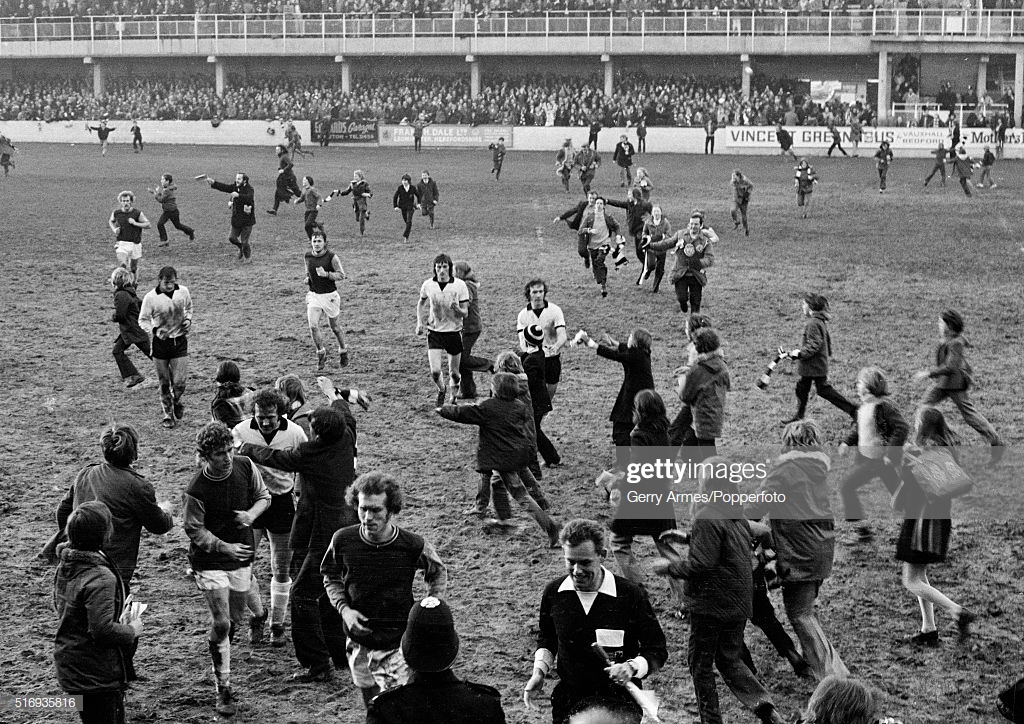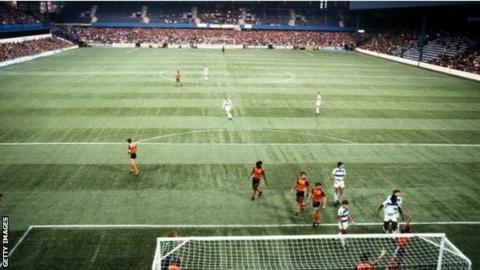Mud, Poor Pitches and the FA Cup
The state of the playing surface – and specifically, mud – has been a concern of English football since its earliest days. Many clubs spent their formative years using makeshift pitches on public or private land, in conditions which did not encourage ‘the beautiful game’. Even by 1888 and the founding of the Football League, Preston’s ‘Invincibles’ had to contend with poor surfaces, as related by one of their key players, John Goodall, in Mark Metcalf’s account of that first season:
“In 1888/89, the pitch at Deepdale was not particularly conducive to good play, often being heavy in the middle with the ball sticking in the mud on wet days. Nevertheless, Preston still played some fine football there.”
The history of early grounds is littered with even worse examples, many documented by stadium historian Simon Inglis. Blackburn Rovers had searched for a home, and “only in mid-1876 did they settle on a field at Oozehead, in the centre of which lay a drainage pool or ‘cow-pit’, which had to be covered with turf laid on planks.” Bolton’s Pikes Lane was “a mud-larkers’ paradise after a few showers of rain”. Newton Heath, the club who were to become Manchester United, played at Bank Street until 1910, “a mud-heap” at one end and “hard as flint” at the other. Millwall found themselves at East Ferry Road, where “the area was thick with mud dumped from excavating the nearby docks. Fred Pelly of Corinthians remarked that after he had fallen on Millwall’s new pitch ‘the smell wouldn’t come off for weeks’.” Charlton Athletic moved to the Valley in 1919, the site of a chalk-pit quarry known locally as The Swamps, where “thousands of fans dug out the pitch from the quarry as the club had no money”. These were pitches built on rubbish dumps and waste land, with little or no regard to drainage, when “very few clubs employed the services of a full-time, trained groundsman.”

The Valley – Charlton v Preston, February 1937 
White Hart Lane – Tottenham v Leeds, FA Cup January 1954
Along with clubs taking the competition seriously and fielding full-strength teams, another traditional feature of the FA Cup has largely disappeared in recent years – the mud. The modern Premier League manager, used to perfect playing surfaces year-round, would find their blood pressure rocketing at the mere sight of one of the mud-baths from previous decades. In 2018, Tottenham’s Mauricio Pochettino took exception to the state of Rochdale’s Spotland pitch before their Fifth Round tie, insisting it posed a “massive risk” to his players. Amid the ensuing controversy, the surface was replaced, with Spurs believed to have contributed to the costs. Pitches naturally tended to be at their worst in the English mid-winter, just as the FA Cup Third Round, one of the most eagerly-awaited days in the football calendar, came around in early January. In addition to mud, players often had to contend with ice and snow.
The conditions undoubtedly contributed to a number of famous Cup upsets, such as Southern League Hereford’s victory over First Division Newcastle in 1972, with Ronnie Radford striking an unforgettable goal out of the Edgar Street mud. Two years later, as a Football League side, Hereford knocked out West Ham on the same boggy pitch. Another classic giant-killing took place at The Shay, home of Halifax Town, when the Fourth Division strugglers beat Malcolm Allison’s Manchester City in January 1980, on a sodden surface with hardly a blade of grass to be seen.

Even the Cup Final, then the showpiece of the English season, wasn’t immune – although it was the decision to hold the Horse of the Year show on the Wembley pitch, rather than the weather, that was responsible. The 1970 final between Chelsea and Leeds was the most notable casualty, played on a rutted and heavily-sanded surface; the replay was moved to Old Trafford. The warning signs at Wembley had been there a year earlier when Swindon shocked Arsenal in the League Cup final on an abysmal pitch, which Arsenal goalkeeper Bob Wilson noted “you would never be allowed to play on now.”

While those Wembley finals were an aberration, poor playing conditions were certainly not confined to the lower divisions in pre-Premier League days – up to the 1980s, Derby County’s Baseball Ground, Leicester City’s Filbert Street and Old Trafford were among the many top-flight venues with ‘heavy’ pitches. On one infamous occasion, the penalty spot at the Baseball Ground, buried under thick mud, had to be re-painted by the groundsman during a First Division game with Manchester City in 1977. Extreme weather conditions would bring mass postponements due to frozen or water-logged pitches – the severe winters of 1946-47 and 1962-63 caused chaos. When games did go ahead, the wintry sight of an orange football on snow-covered grounds was a common one. Some managers, such as Major Frank Buckley at Wolves and Brian Clough at Derby, even chose to water already-soaked surfaces, believing their sides would benefit most from the adverse conditions.

Alongside improvements due to better understanding of drainage and undersoil heating, by the eighties there was a move in English football to adopt artificial playing surfaces. These had been developed in previous decades for American sports and used in the North American Soccer League. QPR led the way in the Football League, installing their Omniturf all-weather surface at Loftus Road in 1981, followed by ‘plastic pitches’ at Luton, Oldham and Preston, despite the objections of purists. Unpopular for their irregular bounce and potential for injury, clubs argued that they allowed for year-round use, minimised postponements and were still preferable to mud. The FA eventually outlawed these surfaces in 1995, though they continue to be used for professional football in other parts of the world, with advances in technology allowing them to replicate real turf much more closely than the 1980s prototypes. Many clubs now use the Desso GrassMaster, a hybrid method which combines natural grass with artificial fibres to create a solid, stable structure. The modified surface, durable with excellent drainage, is now the model across both playing and training pitches. For better or worse, mud, one of the traditional variables of match conditions, has effectively been removed from top-level football.

The most significant development in English football the last 20 years has been the increased understanding of turf management.
Hello Oronde and thank you for taking the time to comment on the blog. Absolutely, the transformation of pitches has changed the way the game is played in England, from the top level through to youth football on perfect surfaces. It’s fair to say the pitches I grew up with – playing and watching – didn’t exactly encourage a possession-based passing style!